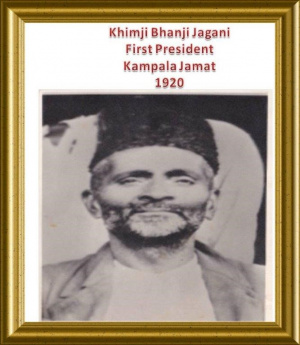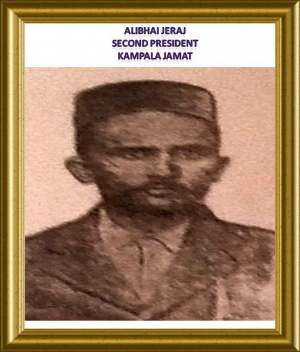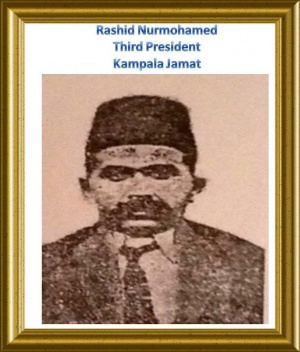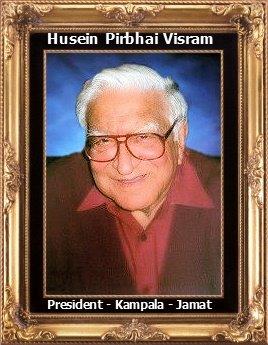Difference between revisions of "Kampala test page"
m |
|||
| (13 intermediate revisions by 2 users not shown) | |||
| Line 20: | Line 20: | ||
==== The First Khoja Shia Ithnasheri Conference in Kampala 1956 ==== | ==== The First Khoja Shia Ithnasheri Conference in Kampala 1956 ==== | ||
| − | [[File:Khoja_Shia_Ithnasheri_Conference_First_In_Kampala_1956.jpg| | + | [[File:Khoja_Shia_Ithnasheri_Conference_First_In_Kampala_1956.jpg|caption]] (space for description) |
| − | |||
===Exodus of Khojas from Uganda=== | ===Exodus of Khojas from Uganda=== | ||
| Line 30: | Line 29: | ||
Needless to say that Shia people from Africa thought of migration. This time the reasons were political rather than economical. In the wake of Uganda exodus, Khoja Shias from other parts of Africa girded up their loins to pre-empt anything similar happening to them. Within a space of four years after 1972, many Khoja Shia Ithna-Asheris of Africa found their new homes in England, the U.S.A., Canada, other European countries, the Middle East- with a section of them back home in India or Pakistan. Their ties with the Federation of Africa gradually became weaker, despite being constantly haunted by the memory of the Sweet and happy days in Africa. | Needless to say that Shia people from Africa thought of migration. This time the reasons were political rather than economical. In the wake of Uganda exodus, Khoja Shias from other parts of Africa girded up their loins to pre-empt anything similar happening to them. Within a space of four years after 1972, many Khoja Shia Ithna-Asheris of Africa found their new homes in England, the U.S.A., Canada, other European countries, the Middle East- with a section of them back home in India or Pakistan. Their ties with the Federation of Africa gradually became weaker, despite being constantly haunted by the memory of the Sweet and happy days in Africa. | ||
| + | The dislocation of Khoja Shia Ithna-Asheris from Uganda, coupled with a steady migration from other parts of Eastern Africa, and Madagascar, had a traumatic effect on the Community. Within the society, the tremors were unmistakably felt, and the psychological effects upon the minds and morals of the people were great and telling. The most remarkable feature of these new settlements, however, is that no sooner did they settle down in the new lands, than they began organizing themselves in the same old fashion as that of Eastern Africa. Here again there were Jamaats, based on nearly the same type of constitution, and religious projects receiving the same attention as before. Within a very short period, buildings for Mosques, Imambadas and Alim quarters were either purchased or built. The cost of such undertakings had risen inexorably, and the capital investments in Eastern Africa stood in no comparison. Yet, the projects were completed successfully. | ||
| + | |||
| + | |||
| + | In order to recompense the terrible loss sustained as a result of the expulsion and forced migration it was absolutely necessary to re-enact an external surrounding compatible to the acquired living habits. Mosques and Imambades served to mitigate the distress, gave a feeling of having partly recovered what had been lost, and, of course, provided a spiritual comfort so necessary for the depressed souls. To this end, money poured in copiously. Was it an urge to pay any price for spiritual comfort? Or was it a religious zeal whipped up by frenzy? Or both, or perhaps neither? Perhaps it was only a pure intention to remember Allah and submit to His will and pleasure against all odds and adversities. | ||
| + | |||
| + | |||
| + | In 1975, a meeting was convened in London to discuss the need of a central organization, this time not only for the Community in the West, but for the entire Khoja Shia Ithna-Asheri population of the World. In exactly the same fashion as it was done thirty years ago, an ad hoc committee prepared a draft Constitution for approval and adoption by the Conference c'onvened for the purpose in the ensuing year, and thus the World Federation of Khoja Shia Ithna-Asheri Muslim Communities was born. | ||
== Geography == | == Geography == | ||
| Line 48: | Line 54: | ||
| − | == Presidents == | + | == Presidents of the Kampala Jamaat == |
'''The following is a chronological list of Presidents of the Kampala Jamaat:''' | '''The following is a chronological list of Presidents of the Kampala Jamaat:''' | ||
| − | ===Khimji Bhanji Jagani=== | + | 1.Marhum Khimji Bhanji |
| + | |||
| + | ===Khimji Bhanji Jagani 1920=== | ||
| + | |||
| + | [[File:Khimji Bhanji Jagani.jpg|frameless]] | ||
| + | |||
| + | First President of the Jamaat | ||
| + | |||
| − | |||
| − | |||
| − | |||
| + | 2.Alibhai Jeraj | ||
===Alibhai Jeraj=== | ===Alibhai Jeraj=== | ||
| Line 63: | Line 74: | ||
[[File:Alibhai Jeraj.jpg|frameless]] (space for description) | [[File:Alibhai Jeraj.jpg|frameless]] (space for description) | ||
| − | |||
| + | |||
| + | |||
| + | 3.Rashid Noormohamed | ||
===Rashid Nurmohamed=== | ===Rashid Nurmohamed=== | ||
| Line 70: | Line 83: | ||
[[File:Rashid Nurmohamed.jpg|frameless]] (space for description) | [[File:Rashid Nurmohamed.jpg|frameless]] (space for description) | ||
| − | |||
| + | |||
| + | |||
| + | 4.Alarakhia Kassam | ||
| + | |||
| + | 5.Mohamedali A Ramji | ||
| + | |||
| + | 6.Akbarali Nathoo | ||
| + | |||
| + | 7.Habib Walji | ||
| + | |||
| + | 8.Haji Merali | ||
| + | |||
| + | 9.Sultanali Gulamhusein | ||
| + | |||
| + | 10.Gulamhusein K Jetha | ||
| + | |||
| + | 11.Fidali.D.Pardhan | ||
| + | |||
| + | 12.Husseinali P Visram | ||
| Line 78: | Line 109: | ||
[[File:Husein Pirbhai Visram.jpg|frameless]] (space for description) | [[File:Husein Pirbhai Visram.jpg|frameless]] (space for description) | ||
| − | President | + | President of the Kampala Jamat. |
| + | Born in Bukoba (1928-2007) | ||
| + | Died in Vancouver BC | ||
| + | President Kampala Jamaat for 6 Years | ||
| + | |||
| + | |||
| + | 13.Massumali D Pardhan | ||
| + | |||
| + | 14.Gulamali M.A.Ramji | ||
| + | |||
| + | 15.Ebrahim.A.Kassam | ||
| + | |||
| + | 16.Sultan.Datoo | ||
| + | |||
| + | 17.Pyarali.Khimji | ||
| + | |||
| + | 18.Asgharali.G.Moledina | ||
| + | |||
| + | 19.Shabbir.H.Najafi | ||
| + | |||
| + | 20.Mustafa.G.Kanji | ||
| + | |||
| + | 21.Shiraz.P.Walji | ||
| + | |||
| + | 22.AbbasAli Lilani | ||
| + | |||
| + | 23.Hussainali Merchant | ||
| + | |||
| + | 24.Hassanali G.A.Ramji | ||
| + | |||
| + | 25.Mohamad Imran Sherrif | ||
Latest revision as of 10:59, 1 November 2018
Kampala is the national capital, commercial hub and largest city of Uganda. In addition to its historic buildings, enchanting typography and blend of cultures, there are several intriguing places to explore for people visiting Kampala for leisure or business.
Kampala city proper contains an area of 73 square miles (189 square kilometers), within which an estimated 1.7 million people live. Surrounding Kampala is the rapidly growing Wakiso District, whose population more than doubled between 2002 and 2014 and now stands at over 2 million. Kampala was named the 13th fastest growing city on the planet, with an annual population growth rate of 4.03 percent.
Kampala has been ranked the best city to live in East Africa ahead of Nairobi and Kigali by Mercer, a global development consulting agency based in New York City.
Etymology
Before the arrival of the British colonists, the Kabaka of Buganda had chosen the zone that would become Kampala as a hunting reserve. The area, composed of rolling hills with grassy wetlands in the valleys, was home to several species of antelope, particularly impala. When the British arrived, they called it "Hills of the Impala". The language of the Baganda, Luganda, adopted many English words because of their interactions with the British. The Baganda translated "Hill of the Impala" as Akasozi ke'Empala – "Kasozi" meaning "hill", "ke" meaning "of", and "empala" the plural of "impala". In Luganda, the words "ka'mpala" mean "that is of the impala", in reference to a hill, and the single word "Kampala" was adopted as the name for the city that grew out of the Kabaka's hills. Traditionally, Kampala was a city of seven hills, but over time it has come to have a lot more.
History
The city grew as the capital of the Buganda kingdom, from which several buildings survive, including the Kasubi Tombs (built in 1881), the Lubiri Palace, the Buganda Parliament and the Buganda Court of Justice. In 1890, British colonial administrator Frederick Lugard constructed a forum along Mengo Hill within the city, which allowed for the British to occupy much of the territory controlled by the Baganda, including Kampala. In 1894, the British government officially established a protectorate within this territory, and in 1896, the protectorate expanded to cover the Ankole, Toro Kingdom, and Bunyoro kingdoms as well. In 1905, the British government formally declared the entire territory to be a British colony. From that time until the independence of the country in 1962, the capital was relocated to Entebbe, although the city continued to be the primary economic and manufacturing location for Uganda. In 1922, the Makerere Technical Institute, now known as Makerere University, started as the first collegiate institution both within Kampala, and within the British colonies on the east coast of Africa. Following the 1962 independence, Milton Obote became president of Uganda, and held the position until 1971, when former sergeant Idi Amin defeated his government in a military coup. Idi Amin proceeded to expel all Asian residents living within Kampala, and attacked the Jewish population living within the city. In 1978, he invaded the neighboring country of Tanzania, and in turn, the government there started the Uganda–Tanzania War, which created severe damage to the buildings of Kampala. The city has since then been rebuilt with new construction of hotels, banks, shopping malls, educational institutions, and hospitals and the improvement of war torn buildings and infrastructure.
Settlement of Khojas in Uganda
(add info)
The First Khoja Shia Ithnasheri Conference in Kampala 1956
Exodus of Khojas from Uganda
The revolution of Zanzibar in 1964 was followed by the exodus of Asians from Uganda in 1972. They were asked to leave the country for good. The Khoja Shia Ithna-Asheri settlement in Uganda disappeared since then. This dismemberment, besides causing untold miseries to the affected families, placed the Africa Federation face to face with a hitherto unconceived situation. The great one-third limb was now amputated, and while World agencies and governments came to the rescue of the Ugandan refugees on a humanitarian basis, the Federation set itself busily to assist its Community members dutifully.
Needless to say that Shia people from Africa thought of migration. This time the reasons were political rather than economical. In the wake of Uganda exodus, Khoja Shias from other parts of Africa girded up their loins to pre-empt anything similar happening to them. Within a space of four years after 1972, many Khoja Shia Ithna-Asheris of Africa found their new homes in England, the U.S.A., Canada, other European countries, the Middle East- with a section of them back home in India or Pakistan. Their ties with the Federation of Africa gradually became weaker, despite being constantly haunted by the memory of the Sweet and happy days in Africa.
The dislocation of Khoja Shia Ithna-Asheris from Uganda, coupled with a steady migration from other parts of Eastern Africa, and Madagascar, had a traumatic effect on the Community. Within the society, the tremors were unmistakably felt, and the psychological effects upon the minds and morals of the people were great and telling. The most remarkable feature of these new settlements, however, is that no sooner did they settle down in the new lands, than they began organizing themselves in the same old fashion as that of Eastern Africa. Here again there were Jamaats, based on nearly the same type of constitution, and religious projects receiving the same attention as before. Within a very short period, buildings for Mosques, Imambadas and Alim quarters were either purchased or built. The cost of such undertakings had risen inexorably, and the capital investments in Eastern Africa stood in no comparison. Yet, the projects were completed successfully.
In order to recompense the terrible loss sustained as a result of the expulsion and forced migration it was absolutely necessary to re-enact an external surrounding compatible to the acquired living habits. Mosques and Imambades served to mitigate the distress, gave a feeling of having partly recovered what had been lost, and, of course, provided a spiritual comfort so necessary for the depressed souls. To this end, money poured in copiously. Was it an urge to pay any price for spiritual comfort? Or was it a religious zeal whipped up by frenzy? Or both, or perhaps neither? Perhaps it was only a pure intention to remember Allah and submit to His will and pleasure against all odds and adversities.
In 1975, a meeting was convened in London to discuss the need of a central organization, this time not only for the Community in the West, but for the entire Khoja Shia Ithna-Asheri population of the World. In exactly the same fashion as it was done thirty years ago, an ad hoc committee prepared a draft Constitution for approval and adoption by the Conference c'onvened for the purpose in the ensuing year, and thus the World Federation of Khoja Shia Ithna-Asheri Muslim Communities was born.
Geography
Climate
Kampala has a tropical rainforest climate (Af) under the Köppen-Geiger climate classification system.
A facet of Kampala's weather is that it features two annual wetter seasons. While the city does not have a true dry season month, it experiences heavier precipitation from August to December and from February to June. However, it's between February and June that Kampala sees substantially heavier rainfall per month, with April typically seeing the heaviest amount of precipitation at an average of around 169 millimetres (6.7 in) of rain. Kampala has been frequently mentioned as a lightning-strike capital of the world.
Places of Interest
(add info)
Downtown Kampala
Presidents of the Kampala Jamaat
The following is a chronological list of Presidents of the Kampala Jamaat:
1.Marhum Khimji Bhanji
Khimji Bhanji Jagani 1920
First President of the Jamaat
2.Alibhai Jeraj
Alibhai Jeraj
3.Rashid Noormohamed
Rashid Nurmohamed
4.Alarakhia Kassam
5.Mohamedali A Ramji
6.Akbarali Nathoo
7.Habib Walji
8.Haji Merali
9.Sultanali Gulamhusein
10.Gulamhusein K Jetha
11.Fidali.D.Pardhan
12.Husseinali P Visram
Husein Pirbhai Visram
President of the Kampala Jamat. Born in Bukoba (1928-2007) Died in Vancouver BC President Kampala Jamaat for 6 Years
13.Massumali D Pardhan
14.Gulamali M.A.Ramji
15.Ebrahim.A.Kassam
16.Sultan.Datoo
17.Pyarali.Khimji
18.Asgharali.G.Moledina
19.Shabbir.H.Najafi
20.Mustafa.G.Kanji
21.Shiraz.P.Walji
22.AbbasAli Lilani
23.Hussainali Merchant
24.Hassanali G.A.Ramji
25.Mohamad Imran Sherrif





